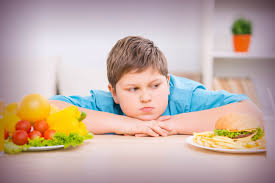We all know about the childhood obesity “epidemic”. As a parent, it may seem like an uphill battle when your opponents are Chester Cheetah, Tony the Tiger, Ronald McDonald, The Pillsbury Doughboy, Aunt Jemima, and Colonel Sanders. But there IS hope. There are some ways you can prevent the epidemic from spreading into your house if you’re creative enough. this article from westonaprice.org outlines 16 simple, yet helpful ways to create a good relationship between your child and healthy food, without creating an obsession that will haunt them into adulthood.
Sixteen Ways to Help Overweight Kids

What a difficult situation it is when weight already becomes an issue at a young age. Here in the U.S., where our government has so utterly messed up our food supply, it’s not easy dodging the junk food landmines all around us. Sadly, childhood obesity has become increasingly common, and it’s a huge stress on both the parents and the child. The child not only suffers from emotional distress, but also faces many health issues that go along with obesity.
Each situation will be unique, of course, but if you have a child in your life who struggles with his weight, this article offers some suggestions and ideas to help. Note: I make the assumption that if you’re reading this, you are already somewhat familiar with the Weston Price way of eating and may already be implementing many of the Wise Traditions dietary principles. The suggestions that follow build on that foundation.
KEEP IT LOW-KEY
Keep the issue as low-key as you possibly can. Do not let this be the start of an obsession about weight for the rest of your child’s life. Avoid long conversations about their size, and do not bring it up much (if at all). Try not to let your children hear you lamenting about your weight or how you look. If they mention how they see themselves, just reply matter-of-factly, “It’s good that you want to be healthy; we should all eat better and get moving more. For dinner, let’s try finding a new healthy recipe that looks good and later go for a walk (play tennis, swim, etc.) together!”
GET MOVING
Get moving together. You can’t just tell a kid who has always been more sedentary or who isn’t in the habit of being on the move to go exercise without joining in and making it fun. Our kids are always watching us, and they need to see us enjoy being active, too.
LIMIT SNACKS
Limit in-between meal snacks. However, if your child asks for one, again keep it low-key. Offer some cheese, a meat stick from a farmer you trust or another healthy snack option (see the WAPF Shopping Guide1 for ideas). You can also just matter-of-factly say, “We’ll have dinner soon and I want you to be hungry. Why don’t you see if your friend can play until then?” It’s also good to have a no-snacking-after-dinner rule.
COOK TOGETHER
Involve your children in the kitchen. Kids are more likely to eat what they help make. I’ve seen this repeatedly with our own children. You could use this strategy when introducing new recipes and also take advantage of this time to talk about why you use foods with certain ingredients and avoid others. Teaching your kids to cook is one of the best lifelong gifts you can give them. In addition, take them to farms or farmers markets so they can see where healthy foods come from. Consider growing a garden together, even if it’s just in some pots on your patio. As they help you, you are also teaching them another important lesson—that real, healthy foods taste much better! If their palate doesn’t appreciate this yet, it will in time.
QUALITY NOT QUANTITY
Fill your children up with healthy fats2 and try to eat more lower-carb foods as a family. For example, make burger salads for everyone, instead of letting some of the kids have a bun and some not. With carbs such as breads, pasta, rice, potatoes or sweets, quietly watch the portions. When you know your child has had enough, drum up some distractions and transition to something else fun—a puzzle, books, playing outside, a family activity or whatever works for your child. Maybe even bring it up before you eat: “After we’re done with dinner, we’re going to _____.” That can help to get the focus off food. Be careful with this one, though, because if your child starts feeling deprived, you could cause more harm than good and turn food into an obsession.
KEEP SCREENS OUT OF BEDROOMS
Keep TVs and video games out of your child’s bedroom. Even better, limit video game time unless they’re playing a game like the Wii where lots of motion is involved—that one is a great way to get the whole family moving. Admittedly, limiting screen time is not always easy to implement—trust me, I know—I’ve had three teenage boys. At the very least, limit their time to an hour a day if you can. When they know their time is up, they become “sooooo bored” and then I cheer inside and think, “Perfect!” Bored kids will inevitably go find something to do outside!
KEEP JUNK FOOD OUT OF THE HOUSE
Don’t stock junk food in the house. There will be fewer battles—they can’t hound you for what isn’t there. I can’t stress this one enough! You may still hear complaints sometimes about how “there’s nothing good here to eat,” but they’ll get over it. Eventually, they’ll find a snack and if they don’t, even better, because then they’ll be nice and hungry for their next nutrient-dense meal. This really works.
PACK A LUNCH
Always send your children to school with lunch packed at home.3 This is very important because what passes for “food” in most school hot lunches is downright disgusting. It’s no wonder kids are struggling not just with their weight but also with being able to sit still and learn.
LIMIT BUT DON’T BANISH SWEETS
Limit sweets at home, but don’t make a big deal if you go out for ice cream or have another treat now and then. The best option is to make your own dessert because you’ll know what’s in it—and what’s not. You can even play with recipes a bit to lower the amount of sugar and use better grains. These days, there are many “keto dessert” recipes online—make it a challenge to find more of those recipes that you and your children can whip up together. Just make sure there are plenty of “better” options at home that taste good, so that your children can more easily avoid all of the junky temptations out in the world.
READ LABELS
Read labels like crazy and teach your kids to do so as well. Avoid trans fats (partially hydrogenated oils—usually soybean, corn or canola), MSG and high-fructose corn syrup like the plague. These have been strongly linked with obesity, diabetes and other health issues. Most Weston Price followers have known to avoid those scary ingredients for a while now, but even the mainstream media are starting to mention studies showing that “ultra-processed” diets cause weight gain.4 Remember also to beware of chemical preservatives and fake colors and flavors. Thankfully, none of these is difficult to avoid if you buy organic; however, while buying organic may help you avoid a lot of bad ingredients, it does not guarantee nutrient-density. Mostly we should be eating and cooking with whole foods, but buying organic for an occasional “junk food” is sometimes a necessary compromise with kids and especially teenagers.
DON’T FORGET THE COD LIVER OIL
Taking cod liver oil helps to balance out our fatty-acid ratios, which has been shown to reduce heart disease, diabetes and obesity. Cod liver oil provides vitamins A and D, which will help your child be more active.
AVOID ENDOCRINE DISRUPTERS
Watch out for the endocrine disrupters in your kids’ environment, which can wreak havoc on their growing bodies. These chemicals are in most plastics (never put warm food in plastic containers), in non-stick pans, in soy foods and in almost all skincare and makeup products as well. My website describes the skincare products that my daughter and I use.5
SUPPORT GUT HEALTH
Be sure to address your children’s gut health as this plays a huge role in maintaining a healthy weight.6 Overweight kids definitely need to be on a good spore-based probiotic, as well as eating as many fermented foods such as sauerkraut or homemade fermented pickles as possible. Consider making kefir soda or kombucha with them for a healthier soda pop.7
GOOD FATS, NOT LOWFAT
Get plenty of good fats and make sure your child does not consume lowfat dairy! Healthy fats like butter, other animal fats and full-fat dairy fill us up so we’re less likely to need a snack later or crave empty carbs. Nina Planck explains in her book, Real Food: What to Eat and Why, that calcium absorption may be the key to why studies show that people who consume more milk, yogurt and cheese lose fat (especially belly fat) and gain lean muscle.8 Planck quotes a nutrition professor, Michael Zemel, who found that calcium from dairy foods is “strikingly more effective than calcium from fortified foods or supplements” for stimulating weight loss. When our body is well nourished, it doesn’t store extra fat in “fear” that it won’t have what it needs. As a bonus, foods with good fats taste great, too.
DEVELOP SKILLS AND CONFIDENCE
It’s inevitable that kids with weight issues are going to struggle with low self-esteem, at least to some degree, so building confidence in some area of their life will be crucial. Find whatever it is that your children are good at and help them further develop these skills or hobbies. This will also keep them more active.
ROLE-PLAY CHALLENGING SITUATIONS
Lastly, other kids (or even adults) can be cruel, as we all know, and your child is bound to hear about how they look from some little snot. Praise them often for all their many wonderful qualities (without being phoney or giving empty praise, because kids see through that) and tell them how great you think they are and how much you love them, no matter what. Be that safe person in their life who they can always come to when they’re sad. Let them know you understand how they feel, and share whatever it was that you were teased about as a kid. Role-play with them and try out ideas for how to handle a similar situation in the future. This also may be a good way to get them giggling a little and lighten up the issue for them a bit.
If you have an overweight child, my heart goes out to you—and the child! Hopefully these suggestions will help you help your child live a full, healthy life, knowing how to nourish themselves well.
SIDEBARS
KID-PLEASING LOWER-CARB FOODS
• If you can find healthy luncheon meat with no weird ingredients or—even better—get some from your farmer, spread on some cream cheese (cheddar is good, too) and roll it up around some crunchy veggies. We love these meat-and-cheese roll-ups around green onions or pickles for a delicious burst of flavor.
• Make homemade ice cream—yes, you read that right. If my kids want a little of this for breakfast, I let them because there’s less sugar in homemade ice cream than in a pancake smothered in syrup. Plus, homemade ice cream is loaded with healthy fats.
• Smoothies are delicious. You can easily use unrefined sugars and control the amounts of sweetener used.
• Hard-boiled eggs are great for quick snacks. Many kids love them with a little sea salt and pepper.
• Make bacon! No more words are necessary, right?
• Dip veggies in a homemade ranch dressing.
• For a crunchy snack, you can find parmesan cheese “crackers” at the store with only one ingredient!
• There are many more keto and low-carb snacks and recipes on my blog.9
ALTERNATIVES TO CANDY
In her 2010 Wise Traditions article on “zapping sugar cravings,” Jen Allbritton shared the following strategies for rewards that are not candy-based.10
When it comes to food, I am quite the negotiator. Brainstorm on what your child enjoys most. Maybe you limit your child’s time with the TV. A piece of candy received at school can be traded for an extra half-hour show, staying up fifteen minutes past normal bedtime, or an extra trip to the pool over the weekend. A ticket system could be devised to work up to something bigger, such as a doll or a pair of in-line skates. Use your imagination to make active family fun more tempting than sugar. Also, you can offer your child’s teacher or Girl Scout group leader ideas for rewards or gifts instead of candy. Depending on the age, consider nickels or dimes, balloons, pencils, bookmarks, crayons, ribbons, glow bracelets, stickers, and other little trinkets from the dollar store. It may even be worth purchasing these alternatives to make the switch happen.
REFERENCES
1. https://www.westonaprice.org/about-us/shopping-guide/.
2. “Know your fats introduction.” https://www.westonaprice.org/health-topics/know-your-fats/know-your-fats-introduction/.
3. Allbritton J. Packing the perfect lunch box. Wise Traditions, Summer 2007;8(2):59-62.
4. Hall KD, Ayuketah A, Brychta R, et al. Ultra-processed diets cause excess calorie intake and weight gain: an inpatient randomized controlled trial of ad libitum food intake. Cell Metab 2019 May 10.
5. “My girly girl inspired this big move to safer skincare.” https://kellythekitchenkop.com/my-girly-girl-safer-skincare/.
6. “New l ink between gut bacter ia and obesity.” https://www.sciencedaily.com/releases/2018/02/180223092441.htm.
7. Allbritton J. Who needs soda pop with these bodacious beverages. Wise Traditions, Spring 2008;9(1):64-69.
8. Planck N. Real Food: What to Eat and Why. Bloomsbury USA; 2016.
9. “Healthy low carb / keto meals and snack ideas.” https://kellythekitchenkop.com/keto-meals-and-snack-ideas/.
10. Allbritton J. Zapping sugar cravings. Wise Traditions, Winter 2010;11(4):53-59.
This article appeared in Wise Traditions in Food, Farming and the Healing Arts, the quarterly journal of the Weston A. Price Foundation, Summer 2019


